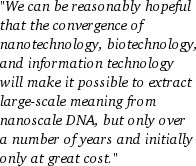Strategies for Personality Transfer
William Sims Bainbridge
page 3 of 15
The basic tendencies are enduring characteristics, including those of genetic origins or established in early childhood. Characteristic adaptations result from an interaction between the basic tendencies and the person’s life experience. Self-concept could  have been characterized under either basic tendencies or characteristic adaptations, but many psychologists and sociologists focus on it exclusively, so McCrae and Costa treat it separately. Objective biography refers to the actions of the person through the life course, and external influences are the environmental factors that shape behavior and personality. The five categories are thus arranged from the most inner to the most outer, with awareness that environment is important across the spectrum, and that the person shapes aspects of his or her environment.
have been characterized under either basic tendencies or characteristic adaptations, but many psychologists and sociologists focus on it exclusively, so McCrae and Costa treat it separately. Objective biography refers to the actions of the person through the life course, and external influences are the environmental factors that shape behavior and personality. The five categories are thus arranged from the most inner to the most outer, with awareness that environment is important across the spectrum, and that the person shapes aspects of his or her environment.
Basic Tendencies
A person’s genetic make-up can readily be preserved in a frozen blood sample or other sample of DNA.
Image 2: DNA double-helix
Collecting DNA samples has become quite routine, as illustrated by the fact that the National Geographic Society offers a collection kit so that people may enter their DNA into its Genographic Project to map human genetic diversity.[1] In 2005, the CVS pharmacy chain distributed free "Protect Your Child" kits for taking a sample of the child’s saliva for identification purposes, along with fingerprints, a photo, and dental record. If the goal is to clone the individual in some future time, then freezing a blood sample is an inexpensive expedient. But if the aim is to infer behavioral characteristics from the individual’s genome, then we face a substantial research challenge. Innovative methods have made it possible to sequence the human genome much faster than had been thought possible[2], but the work remains expensive and many years of fundamental research will be required before we are able to infer personality dispositions from genetics. We can be reasonably hopeful that the convergence of nanotechnology, biotechnology, and information technology will make it possible to extract large-scale meaning from nanoscale DNA, but only over a number of years and initially only at great cost.[3]
Measurement of a person’s large-scale physical characteristics, or anthropometry, is far from new, but it continues to progress in accuracy and scope. Over a century ago, Dr. Jay W. Seaver[4] measured the bodies of thousands of people attending the summer school resort at Chautauqua, New York, using calipers, scales, dynamometers, and templates to trace the contours of spines. By their names, one might never guess that Caesar and Cleopatra were computerized anthropometry projects. The Civilian American and European Surface Anthropometry Resource (CAESAR) Project employed three-dimensional scanning to create detailed computer models of individual bodies for purposes such as designing or evaluating clothing and equipment that needed to fit the human form. Despite the word civilian in the name, the key participant was the Computerized Anthropometric Research and Design Laboratory (CARD) of the US Air Force, with an interest in better-fitting helmets and aircraft cockpits.[5] Cleopatra is a related computerized anthropometric project carried out by the National Research Council of Canada.[6]
Social and behavioral scientists have tended to discount physique as a source of behavioral disposition, but over the years an active minority have argued for its importance. Notably, in 1950 Sheldon and Eleanor Glueck reported that physique could predict juvenile delinquency. To determine the somatotypes (physical forms) of the boys they studied, the Gluecks measured selected distances on standardized photographs of their subjects, categorizing them as endomorphs, ectomorphs, mesomorphs, or balanced physiques that were mixtures of the three main types.Footnotes
1. The Genographic Project web site. (back to top)
2. Venter, J. C., H. O. Smith, and L. Hood. 1996. “A New Strategy for Genome Sequencing,” Nature 381(6581):364-6. (back to top)
3. Johnson, Peter C. 2003. “Implication of the Continuum of Bioinformatics.” Pp. 207-213 in Converging Technologies for Improving Human Performance edited by Mihail C. Roco and William Sims Bainbridge. Dordrecht, Netherlands: Kluwer.
(back to top)
4. Seaver, Jay W. 1890. Anthropometry and Physical Examination. New Haven, Connecticut: Tuttle, Morehouse and Taylor. (back to top)
5. Computerized Anthropometric Research & Design Laboratory (CARD) web site (back to top)